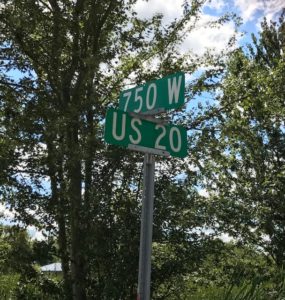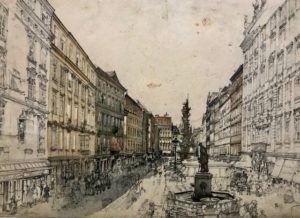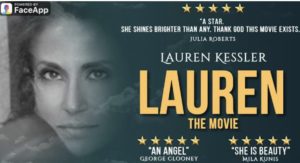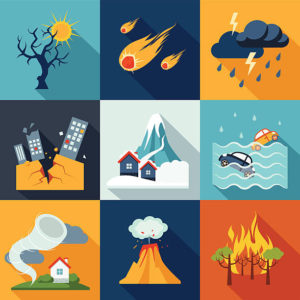Category — Media
Attention must be paid!
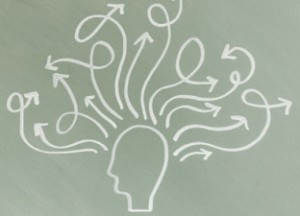
What you are doing right now?
I know one answer: You are reading this essay. Or at least you are reading this sentence that states you are reading this essay.
Did I already lose your attention? In between that sentence and this one, did you:
.Get a buzz on your phone that sidetracked you to a text?
.Get a ping on the laptop that signaled an incoming email that you knew would be garbage, but you had to check it out anyway?
.Have an irresistible urge (meaning you could not resist it, so you did it) to check your Facebook feed?
.And, while scrolling through the heavily curated snippets of other people’s lives, did you find your attention diverted to a reel that took you on a tour of an Emirates first-class cabin? A kitchen hack you will never ever use?
.But was intriguing enough for you to Google it and watch a YouTube?
And then, on your way to the kitchen to brew a cup of tea, you saw out the window, that the cherry tree had popped. So, you had to grab your phone and take a picture. And then, that image was so lovely you just had to post it on your IG account. And as you hashtagged it #springishere, you thought: Shit, spring is here. I need to check out lettuce and broccoli starts at Down to Earth (or whatever your local garden store is). And so, you went to that website.
And now, maybe you are back here, in my literary clutches again. Until I lose you. I mean, wouldn’t it be nice to listen to some music right now? Maybe this? Or perhaps this?
Back again? If I may have your attention for a moment. If we can, in fact, focus our attention for a moment: It is fascinating/ harrowing/ enlightening to focus on how we can’t. Focus, that is. How distracted we are, how easily distracted. How we used to be able to concentrate but find it harder now. How deeply embedded in this non-stop, amped up, constantly accelerating world of information we find ourselves. And how we just have to click over to Zappos right now to see if there’s a big sale on boots because, well, it’s spring. (Yes, I just did that, my friends.)
Here’s a book you may want to read, should read: Stolen Focus: Why You Can’t Pay Attention and How to Think Deeply Again.
And now, go check that email. Because I am sure it is of vital importance. See you next Wednesday.
April 12, 2023 3 Comments
Disaster for ALL!!!
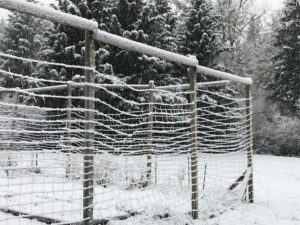
Snowpocalypse. Snowmageddon.
Apocalypse is, like, the end of the world. As in final destruction.
Amageddon is, like, the end of the world. As in Day of Judgement. As in last battle between Good and Evil.
Five inches of snow is, like, five inches of snow. Or, okay, maybe a little more. It get it. It snowed. A lot.
But last week we were inundated with a tsunami of hyberbolic posts on social media. With ginned-up, over-wrought media coverage.
I understand that cities like Seattle and Portland are not geared up (equipment, infrastructure) for harsh winter weather like Chicago and Minneapolis. But geez. Can we please ratchet down the disaster talk?
What does this disaster porn do for us? It makes us feel even more besieged, more vulnerable, more at the mercy of forces beyond our control than we have felt during the past two years of sinking in the quicksand of Trumpism.
And what a disaster for us all, as we are hammered by (and hammer ourselves and each other with) messages of our victimization, as we embrace what psychologists call Learned Helplessness, as we avoid the deep issues and challenges that don’t just zip across the landscape, dump on us for a few days, lose their force and move on.
The disaster of the recent northwest Snowpocalypse? It is that we have people who live on the streets, and cold weather, wet weather, snow make that life even harder and more dangerous than it already is. The disaster is that in Seattle (the ninth richest city in the US) in Portland (the oh-so-hip up-and-comer) in Eugene (so left-leaning it can’t stand up) tens of thousands of people live without shelter from the storm(s).
The disaster is not that the local hardware store is sold out of snow shovels. The disaster is not that it takes longer to commute in to work.
(Watch out! Careful! Read at your own peril! My two previous disaster posts are here and here.
.
February 13, 2019 2 Comments
Route 20 Report #2
What lies between the coasts? That question is at the heart of this 3,365-mile trek, Pacific to Atlantic, along Route 20. It is now the end of day 14, and I am writing this sitting in a tent in a campground on the shores of Lake Erie. The sunset over the lake was vermillion. The crickets have started in. Every 30 seconds an acorn drops from a tree. I can hear a train way off in the distance.
I was born on one coast, and I’ve made my life on the other. Before this trip, I was not ignorant of what lay between west and east. I had put in time in the Midwest. I had crisscrossed the country on I-80, I-90 and I-40 at various times in my life.
But then 2016 happened. And, like so many people, I all of a sudden didn’t think I knew my own country anymore. So that’s what this trip is about.
I’m discovering too much to write about here. And my ah-ha moments come and go, from attempting to understand gun culture to thinking about the meaning of family to wrapping my head around the place of corn in U.S. agriculture—and I don’t mean “sweet corn.” I mean corn used for ethanol, corn used for high fructose corn syrup, mono-culture, endless fields of it.
But one simple (maybe self-evident) thing I’ve discovered is that small towns (that is, most of the towns along Route 20) are more alike than not, whether they be Shelley, Idaho, or Thermopolis, Wyoming; Rushville, Nebraska or Elizabeth, Illinois; or (today) Westfield, New York. The places you never heard of. The places you would never visit unless your great aunt lived there. Some are more prosperous than others. Some are more beautiful than others. All are pretty proud of themselves. All are populated by people who mean no harm (speaking as the white, traveling-through person I am, you understand). The people seem genuinely friendly. They seem to care deeply about each other. The kids—contrary to what I thought—choose to STAY. They all have newspapers, most dating back to the late 1800s. In the cafes, they play the same country music.
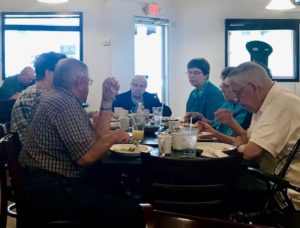 (Celebrating Selma’s 92nd birthday.
(Celebrating Selma’s 92nd birthday.
Breakfast at Friendly Corner, Laurel, Nebraska)
September 13, 2018 4 Comments
How we see the world
We think about, or sometimes try not to think about, how quickly the world is changing around us. I am talking about technology. This is a subject about which I am profoundly ignorant. But I have opinions, dammit!
Every day we are asked to update something (yesterday’s version being, so, you know, yesterday). Every day there are new Apps (like Run Pee, which tells you when you can run and pee without missing an important moment in the movie you are watching). Every day there are new gadgets, new devices. Just 20 years ago I carried a camera, an audio recorder, a note pad, a pen, a little telephone number book, maybe a map, often a pedometer. I wore a watch. My computer sat on my desk next to my telephone answering machine. I had to brush my teeth with a twig. Okay, not that.
Now I have one device—the Austrians call it a “handy,” and it is—that does all of that, and more. That is a huge change. And a fast change.
Yesterday I was reminded of a change I hadn’t really thought about that is far more profound: the change in how we get the images that we hold in our heads. Of course we form those images through seeing, through direct experience. But we also “see” by looking at the images others present us. Today, we see the world through Google images or through posts on Instagram or Facebook, YouTube, satellite pic sites, someone’s blog. We can see everywhere and anywhere, a click, a split-second: Here is the spice market in Istanbul. Here is the Vatnajökull glacier. Here is the backyard of the house I lived in as a child that I have not visited for thirty years.
But what about before the Internet. What about before photography? How did people “see” what they did not experience?
The Aquarell (watercolor) exhibit at The Albertina Museum had one answer for this. Many of the paintings in the exhibit were delicate, evocative, almost ethereal, the way watercolor can be. But the subtext is what interested me. Some of these painters were engaged by adventurers, noblemen and others to document their journeys. The painters used water color—first sketching with pen and ink, then adding color later—because this was a fast way to make a picture, to capture an image: a Parisian street corner, an alpine glacier, a “Gypsy” encampment. They brought the images back as visual records. It is how others saw those distant places. Imagine that.
Imagine never having left your village in Tyrol. Imagine now a trip to Vienna, once in a lifetime. There you see the work of a watercolorist who traveled with a noble across the European continent and chronicled what he saw. Painted it. Those luminous, delicate, evocative images are how you now experience that place. Imagine. I almost can’t.
May 16, 2018 No Comments
Life in the no-Trump zone
Here’s the weird thing. Whenever I’m way from Oregon, even for just a few days, even if I’m just up in Seattle, I get heart-sick. I don’t mean that metaphorically. I mean I really get sick. I get a pain in my chest and a lump in my throat. It’s a love-ache, like when you pine for somebody who’s not there.
But on the other hand, whenever I’m away from the United States, as I have been for the past week and a half, I feel joy and a lightness of being. I am exhilarated. And I am desperate to stay away, to distance myself from the madness, to make someplace else my home. A few days ago, strolling down a several-mile lane that cuts through the leafy length of The Prater (an extraordinary park in the heart of Vienna), breathing the sweet spring air, humming off-key, it suddenly occurred to me that I was not bludgeoning myself with thoughts about the sociopath in the White House and his lily-livered and unprincipled henchmen/women, or agonizing over school shootings, cop shootings, the NRA, or which new cowardly piece of shit had been called out for his cowardly piece of shit aggression toward a woman or, more likely, multiple women. You know, the new normal back in the Land of the Free and the Home of the Brave.
It wasn’t that I was ignorant of the goings-on state-side. I wasn’t on a news fast. The New York Times is delivered to my phone every morning, and I read it. I knew. But I had apparently entered into some meditative state where I acknowledged the information but achieved detachment from it. That’s what being 9 time zones away will do. That’s what being in a country with national health care and virtually free higher education and thirty paid days of vacation every year will do. That’s what being in a country with an incarceration rate ten percent of ours will do. What being in a country with a 98 percent literacy rate where the average amount of time spent READING A NEWSPAPER is 57 minutes will do. This alternate reality has Zenned me out.
And so, I will forgive this country its fat, white, soggy, cheese sauce-smothered asparagus and its Pay to Pee (few and far between) toilets. I will even forgive it for coining
Donaudampfschiffahrtselektrizitätenhauptbetriebswerkbauunterbeamtengesellschaft, a single, 79-letter word that means Association for subordinate officials of the head office management of the Danube steamboat electrical services. Because this a no-Trump zone. Almost. This morning’s der Standard had a (small) front-page story (no photo!) about our fine and thoughtful president and the Iran nuclear deal. It also included the photo that illustrates today’s blog, featuring two sane, well-spoken world leaders who appear to actually like each other. What a concept.
If it were not for Oregon, my Oregon, I would never return.
May 9, 2018 No Comments
I hate FaceApp
File this one under “walk your talk.”
In the seminar I’ve been teaching at University of Washington this winter, we’ve been taking about, reading and creating “empowering narratives.” These are stories that show people working on solutions, stories that present the idea that tough problems can be and are being worked on, that what people do (or don’t do) makes a difference. These narratives appeal not to fear—Oh my god, the opioid crisis! Oh my god so many guns!—but to hope, to the power of action and involvement.
We are also talking about the parallel to this in the advertising world, “Empowerment Marketing.” This is a message strategy that appeals (that is, tries to sell stuff) to people by tapping to their higher instincts: the desire to connect, to be of use, to contribute to the society, to be part of a solution. The way marketing usually works is to appeal to our baser instincts: greed, vanity, self-interest, fear, insecurity. The idea of this pervasive “dark marketing” is to tell us that we are substandard, that we are missing out, that we are lacking…and then to present a product or service that will make us better, shinier, sexier, etc.
So I know all this. I’ve read books about this. I’ve studied the research. I lecture about this. I talk the talk.
Enter FaceApp.
I upload a photo of myself, and FaceApp shows me a gorgeous version of myself that I never before imagined. All of a sudden, I see my real self as…lacking. Okay, kinda ugly. I look at my FaceApp self: that nose! I love that nose! I now am insecure/ vain about my actual nose. I could buy that FaceApp nose! I could spend $6000 and get that nose! And those smoky eyes! Why aren’t my real eyes like that? My real eyes are…lacking. But I can buy cosmetics! I can buy a “make-over” at a salon! I can have those eyes. And don’t get me started about lip plumping.
Whoa.
I have been effectively Dark Marketed. Disempower Marketed. I’ve been ensnared by appeals to my insecurity and vanity. And I know exactly what’s happening. And I fall for it anyway.
But I don’t fall so far that I’ve scheduled a rhinoplasty.
However, this morning, for the first time in, like, a year, I applied mascara.
February 28, 2018 8 Comments
Disaster! Catastrophe! Armageddon!
News you can use.
For those in the path of hurricanes, for those threatened by wild fires, daily, hourly – minute-by-minute — reports and updates are a necessity and a blessing. The media providing these reports offer important, sometimes life-saving information. Thank you for your service.
For the rest of us, deluged not by tropical storms but by a tsunami of hyperbolic media coverage, the purpose of this incessant attention to natural disasters is problematic.* This ginned-up, brave-reporters-holding-onto-poles-in-100-miles-an-hour-wind journalism is overwrought. Of course I care (both in the abstract and because I have family in Florida and Georgia) about people in harm’s way. But, as there is nothing we can do while whatever unfolds unfolds, as we are not ourselves threatened, it seems to me that our position as spectators is uncomfortably like that of drivers slowing down to gawk at a accident by the side of the road. Also, as some media explicitly packaged Harvey, Irma and the forest fires in the west as “Armageddon,” we feel even more besieged, more vulnerable, more victimized by forces beyond our control than we have during the past six months sinking in the quicksand of Trumpism. Now there is a unnatural disaster for you.
For the media, these back-to-back-to-back “catastrophes” are gold. The storms are stories that come neatly pre-packaged in three acts: Act I: The Anticipation, Act II: The Event, Act II: The Aftermath. There’s video, oh so much video. There’s drama you don’t have to look for because it literally slaps you upside the head. No deep reporting necessary. Point the camera at trees whipping in the wind. Stick a mic in the face of a person who made it to a temporary storm shelter. How bad was it? How much did you lose? Insert yourself (and camera) into the ongoing challenges of a first responder. It may be momentarily dangerous for the intrepid reporter, but it is easy peasy. No pesky FOIA requests, no scouring documents, no spending weeks, months trying to understand communities and cultures. And the clicks! Oh Lordy, the clicks. So much traffic to the site. So many eyeballs. What a boon a good disaster is for the media!
And what a disaster for us, as we settle deeply into our lives of spectatorship (football, anyone?), as we are hammered by messages of our victimization, as we embrace what psychologists call Learned Helplessness, as we avoid the deep issues and challenges that don’t just zip across the landscape, dump on us for a few days, lose their force and move on.
*Early on, there was minor attention to the idea that the hurricanes were tied to human-caused climate change. There appeared to be little scientific evidence to support this.
September 13, 2017 No Comments

